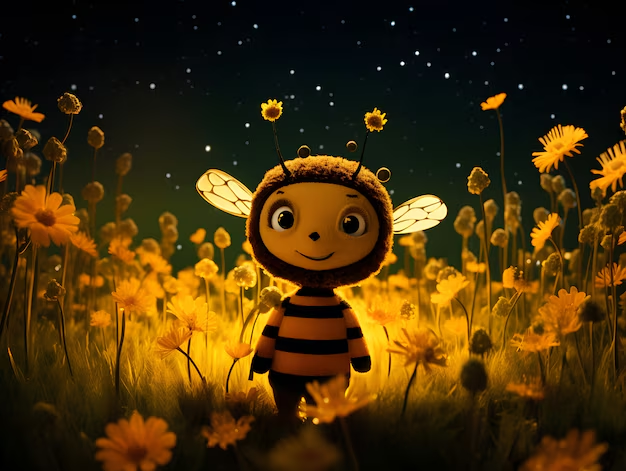A worker bee has a mass of 0.00011 .

The Fascinating World of Worker Bees: Understanding Their Mass and Role
Worker bees, often regarded as the backbone of a honeybee colony, play a critical role in the survival and productivity of their hive. These industrious insects are responsible for tasks ranging from foraging for nectar and pollen to defending the hive, tending to the queen, and producing honey. One of the most intriguing aspects of worker bees is their remarkably small size, which belies their significant impact on the ecosystem. In this article, we’ll explore the mass of a worker bee, why it’s important, and how these tiny creatures contribute to their hive’s success.
The Mass of a Worker Bee
The average worker bee has a mass of approximately 0.00011 kilograms (or 110 milligrams). This lightweight body allows them to be agile and efficient in their duties, particularly when flying long distances to gather nectar and pollen. Despite their small size, worker bees can carry loads that are often more than half their body weight in pollen or nectar back to the hive.
Why the Mass of a Worker Bee Matters
The mass of a worker bee directly affects its energy expenditure, flight ability, and ability to carry resources. A bee’s lightweight body is a perfect design for maximizing efficiency:
- Energy Conservation: A smaller body means less energy is needed for basic functions, allowing bees to stay active throughout the day while foraging.
- Flight Efficiency: Worker bees must travel between flowers and their hive, often flying several miles in one trip. Their light mass enables them to hover and navigate complex environments with precision.
- Resource Carrying: Though they are tiny, worker bees have strong flight muscles, and their ability to carry nectar or pollen back to the hive is key to sustaining the colony.
The Role of Worker Bees in the Hive
Worker bees are females that are not capable of reproduction, unlike the queen bee. Their roles within the hive are numerous and vital for its survival. Here are some of the key tasks they perform:
- Foraging for Nectar and Pollen: Worker bees leave the hive in search of nectar and pollen, which are essential for honey production and feeding the colony.
- Honey Production: After collecting nectar, they convert it into honey by mixing it with enzymes from their saliva and reducing its moisture content.
- Tending to the Queen: Worker bees groom and feed the queen, ensuring she is healthy and able to lay eggs.
- Nursing the Brood: Worker bees care for the developing larvae by feeding them royal jelly, pollen, and honey.
- Hive Maintenance: Worker bees are responsible for cleaning the hive and regulating its temperature. They fan their wings to ventilate the hive, especially during hot weather.
Worker Bee Lifespan and Its Relation to Their Mass
The lifespan of a worker bee varies depending on the time of year and the tasks they perform. During the busy summer months, a worker bee may only live for about 5-6 weeks. This short lifespan is due in part to their high activity levels, which result in a significant energy expenditure despite their small mass. However, during the winter, worker bees live much longer, often up to 6 months, as they conserve energy by remaining inside the hive and clustering together to keep warm.
The Impact of Worker Bees on Agriculture and the Ecosystem
Worker bees play a crucial role in pollination, which is essential for the reproduction of many flowering plants. Their ability to pollinate crops contributes significantly to global food production. Without worker bees, many plants would fail to reproduce, leading to reduced crop yields and a decline in biodiversity. As a result, worker bees are often considered one of the most important pollinators in agricultural ecosystems.
Threats to Worker Bees and Their Mass
Despite their importance, worker bees face numerous threats that jeopardize their populations and, consequently, the ecosystems they support. Understanding these threats can help us take action to protect these essential pollinators.
1. Pesticides
The use of pesticides in agriculture poses a significant risk to worker bees. Chemicals designed to eliminate pests can also harm bees, either directly through contact or indirectly through the consumption of contaminated nectar and pollen. Studies have shown that certain pesticides can impair bees’ foraging behavior, navigation, and even reproductive capabilities. As worker bees are integral to the pollination process, widespread pesticide use can lead to a decline in bee populations and a reduction in agricultural productivity.
2. Habitat Loss
Urbanization, deforestation, and intensive farming practices have led to the loss of natural habitats where bees forage and nest. As the availability of wildflowers diminishes, worker bees struggle to find sufficient food sources. This habitat fragmentation limits their foraging range and can impact the overall health of bee populations. The decrease in diverse flowering plants means that bees may not get the variety of nutrients they need to thrive.
3. Climate Change
Climate change poses a multifaceted threat to worker bees. Changes in temperature and weather patterns can disrupt the blooming cycles of flowers, leading to mismatches between when bees are active and when food sources are available. Extreme weather events, such as droughts and heavy rainfall, can also impact the health of bee habitats. Additionally, warmer temperatures may allow invasive species and diseases to spread, further stressing bee populations.
4. Diseases and Parasites
Worker bees are susceptible to various diseases and parasites, which can weaken colonies. One of the most notorious threats is the Varroa destructor mite, which attaches to bees and feeds on their bodily fluids. This parasitic relationship not only weakens individual bees but also spreads viruses throughout the colony. Other pathogens, such as Nosema fungi and bacterial infections, can further compromise the health of worker bees, leading to increased mortality rates.
The Importance of Conservation Efforts
Given the numerous threats faced by worker bees, conservation efforts are critical to ensuring their survival. Here are some ways individuals and communities can contribute to bee conservation:
1. Creating Pollinator-Friendly Habitats
Planting native flowering plants in gardens and landscapes can provide essential food sources for worker bees. Flowers that bloom at different times throughout the year can ensure a continuous supply of nectar and pollen. Avoiding the use of pesticides in these areas can create a safe haven for bees.
2. Supporting Local Beekeepers
Purchasing honey and other bee products from local beekeepers helps support sustainable practices and promotes healthy bee populations. Local beekeepers often prioritize the well-being of their bees and contribute to the pollination of nearby crops.
3. Advocating for Policy Changes
Supporting policies and regulations that protect pollinators is essential. Advocating for reduced pesticide use, habitat conservation, and funding for research on bee health can contribute to a healthier environment for worker bees.
4. Educating Others
Raising awareness about the importance of worker bees and the challenges they face can inspire others to take action. Sharing information about bee-friendly practices and the critical role bees play in food production can foster a sense of responsibility and stewardship within communities.
Conclusion: The Significance of Worker Bees in Our Ecosystem
Worker bees, with their mass of just 0.00011 kilograms, are not merely small insects but rather vital components of our ecosystem. Their diligent work in pollination supports biodiversity and agricultural productivity, impacting food systems globally. By understanding the challenges they face and the importance of their role, we can take steps to protect these remarkable creatures.
In a world where the health of our ecosystems is increasingly threatened, fostering a greater appreciation for worker bees and actively participating in their conservation can contribute to a more sustainable future for both these industrious insects and humanity. Together, we can help ensure that worker bees continue to thrive, pollinating our crops and supporting the delicate balance of life on Earth.
The worker bee, with a mass of just 0.00011 kilograms, exemplifies the incredible efficiency of nature’s designs. Despite their small size, these bees perform a wide range of tasks that are vital to the success of their hive and the broader ecosystem. From foraging for nectar and producing honey to pollinating crops, worker bees have a profound impact on the world around them. Understanding their biology and the significance of their mass can help us appreciate the delicate balance of nature that they help to maintain.
Read Also: Mother protege of winifred sanderson




